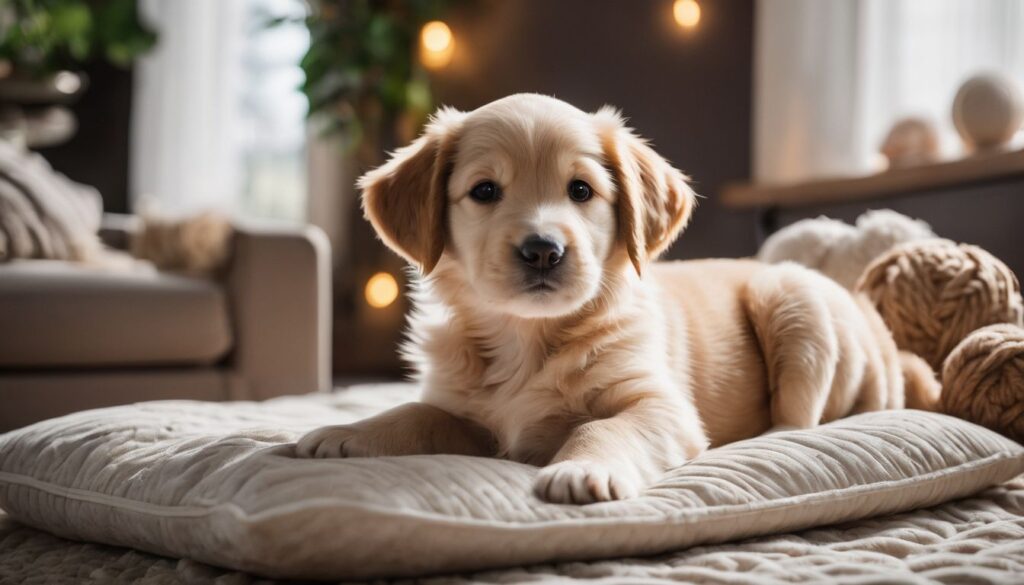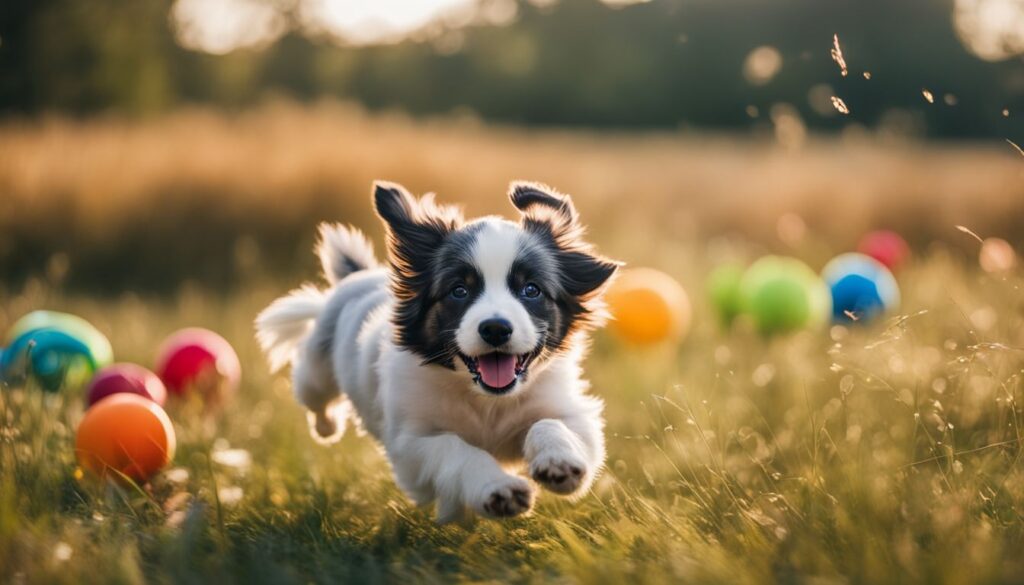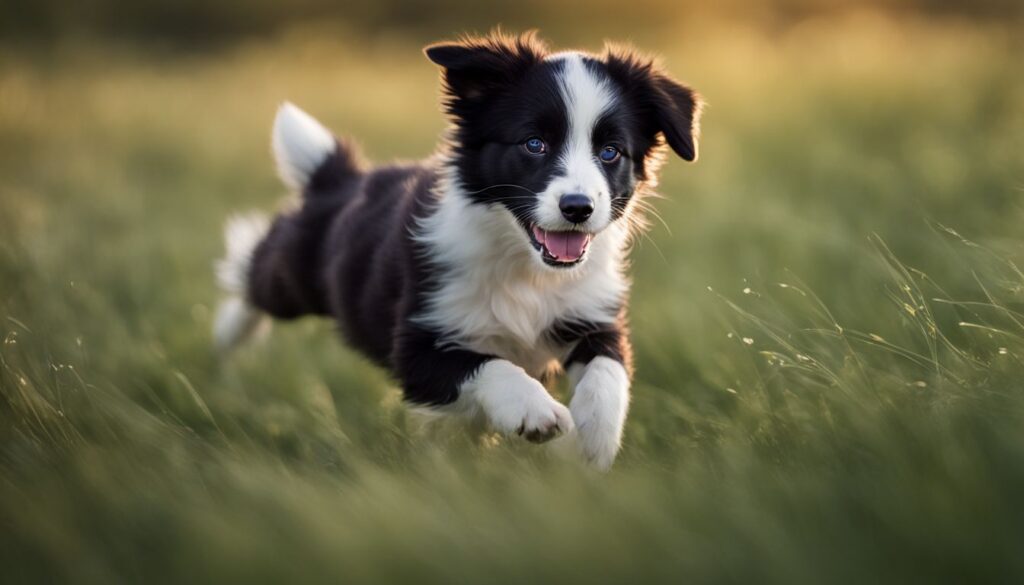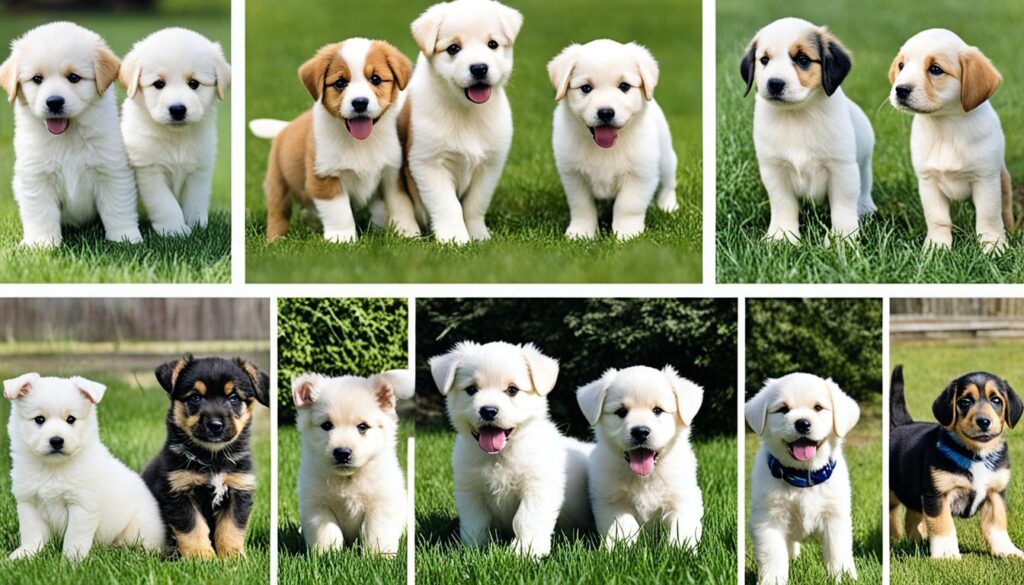
If you’ve ever found yourself chasing a whirlwind of fur around the house, wondering if your puppy has an endless energy button, you’re not alone. Managing a hyperactive puppy can feel like calming a mini tornado that barks.
But here’s the thing – hyperactivity in puppies isn’t just them being playfully naughty; it can be a sign they’re not getting what they need in terms of mental and physical stimulation.
Enter the world of creative solutions! Our furry friends don’t come with an off switch (unfortunately), but some techniques and strategies can help them mellow out. From understanding why your pup acts like they’ve drunk ten cups of coffee to teaching them how to chill out without squashing their spirit, we’ve got you covered.
Plus, did you know? Consistency and patience go a long way in training these energetic fluff balls.
Keep reading for tips on turning your hyper pup into a zen doggo. It’s going to be paw-some!
Key Takeaways
- Teach your puppy to settle down by using crate training, positive reinforcement, and setting a routine. This helps them know when it’s time to rest or play.
- Mixing up physical and mental exercises keeps your puppy engaged and uses their energy in a good way, helping reduce hyper behavior.
- Use calming treats and scents like lavender to help relax your puppy when they’re too energetic.
- Reward calm actions with treats or praise. This shows your puppy that being peaceful is good.
- If your puppy stays hyperactive, talk to a vet or dog trainer for more advice on how to help them calm down.
Understanding Hyperactivity in Puppies
Puppies can show signs of hyperactivity, like excessive barking and restlessness. Understanding possible reasons for this behavior is essential in managing it effectively.
Signs of hyperactivity
Hyperactive puppies are a whirlwind of energy. They go from zero to sixty in seconds, often leaving a trail of chaos in their wake.
- Restlessness: Even after a play session, these little ones can’t seem to settle down. They’re always on the move, pacing around the room or trying to engage anyone and anything in their path.
- Excessive barking: They have an internal megaphone that never turns off. Whether at a leaf blowing past the window or just the sheer joy of making noise, hyperactive puppies love to express themselves loudly.
- Lack of focus: Trying to teach them to sit? Good luck! Their attention is everywhere but on you. One moment, you’ve got their gaze; the next, they’re captivated by a fly buzzing across the room.
- Panting and whining: These pups could run for miles and still gasp like they’ve just started. The constant movement gets them all worked up, leading to endless circles of panting and whining.
Possible causes
Puppies turn into little balls of energy for a couple of reasons. Let’s dive in—lack of physical or mental stimulation takes the top spot. Imagine being so bored that running circles around the living room seems like a fun idea; that’s your puppy without enough to do.
They need play, puzzles, and plenty of exercise to keep their minds and bodies busy. Conversely, too much going on can be just as tricky—overstimulation is real. It’s like when you drink one coffee too many, and suddenly everything feels overwhelming; puppies can feel that way too, with too many noises, people, or even dog clicker sounds buzzing around them.
Boredom loves company and finds a friend in hyperactive puppies who haven’t discovered creative outlets for their energy. Whether they’re chasing their tails or testing the speed limit indoors, it signals they’re missing out on essential mental exercise and puppy play time designed to tire them out rightly.
Think about it—not all games are created equal. Tug-of-war might pump them up more than calming activities like sniffing exercises or gentle herding trials for those bred with specific instincts like border collies or shelties.
So striking the right balance between activity and rest becomes vital in managing those zoomie-inducing triggers.
Managing Hyperactive Behavior in Puppies
Teach your puppy to be calm by providing mental and physical exercise. Use crate training as a way to create a safe space for relaxation.

Encouraging calm behavior
Encouraging calm behavior in hyperactive puppies is a blend of art and science. Patience and consistency is the key to success.
- Start with crate training. It’s like giving your puppy a private room where they can chill and reset. Ensure the crate feels safe and cozy, unlike a timeout zone.
- Positive reinforcement goes a long way. Do you have a moment when your puppy decides to take it down a notch? That’s your cue to bring on the treats or their favorite toy. It tells them, “Hey, being calm gets me goodies!”
- Set up some “place” or “settle” training spots around the house. Use a mat or a bed, something that says, “This is my zen zone.” Every time they use it for calming down, throw them a treat party (well, maybe just one treat—you get the idea).
- Exercise isn’t just about tiring them out; it’s also about engaging that busy brain. Mix things with games that make them think or work for their toys. Mental exercise keeps that hyper energy in check.
- Routine is your path to follow. Dogs love knowing what comes next. Having set times for meals, walks, and play helps dial down the chaos.
Providing physical and mental exercise
To calm hyperactive puppies, physical and mental exercise is crucial. Here are ways to provide these activities:
- Engage in games, puzzles, and training that challenge the puppy’s mind, helping them to focus and relax.
- Incorporate physical activities such as jogging, running, and playing to burn off excess energy.
Crate training
Crate training helps puppies feel secure and calm, providing a quiet space. This technique eases their anxieties and supports obedience training. Introducing crate training is essential: use treats and toys to encourage your puppy to associate them with comfort and safety.
Remember not to force your puppy into the crate; it should be a place of their own choice where they can relax.
Crates also play a crucial role in establishing a routine. By creating a structured environment for your puppy, you can reduce hyperactivity. A consistent routine will help them know when to play, eat, or rest, leading to more balanced behavior throughout the day.
Establishing a routine
A stable routine is essential for managing hyperactivity in puppies. Consistency provides predictability, helping to reduce stress and anxiety. Daily activities like feeding, playtime, and walks should happen simultaneously every day to create a sense of security and stability for your puppy.
Routines also assist in regulating sleep patterns, promoting relaxation and calmness during designated rest periods. Integrating regular training sessions into your daily routine helps to engage your puppy’s mind and encourages self-control through positive reinforcement techniques.
These routines establish a reliable environment where puppies can anticipate their needs being met, minimizing impulsive behaviors caused by uncertainty. Additionally, this stability allows them to develop trust in their surroundings, easing any potential anxiety or restlessness they may experience.
Tips for Calming a Hyperactive Puppy
Engage their nose with relaxing scents, use calming treats, and reward calm behavior. Are you curious to explore more ways to help your hyperactive pup?

Using calming treats
Calming treats can help relax hyperactive puppies. These treats are formulated with ingredients like chamomile, valerian root, and L-tryptophan, which have soothing effects on dogs.
When choosing calming treats, look for ones that are specifically designed for puppies and follow the recommended dosage to avoid overfeeding or adverse reactions.
Introducing these treats during stress or excessive energy can aid in promoting calmness in your puppy. It’s important to note that while calming treats can be beneficial, they should complement other behavior management techniques rather than being the sole solution for managing hyperactivity in puppies.
Teaching practical skills
Teaching practical skills to a hyperactive puppy involves focusing on activities that help them stay calm and disciplined. Using crate training can provide a safe space for the puppy to relax, helping manage their hyperactivity.
Incorporating commands like “sit” and “stay” during feeding times or play sessions helps teach impulse control and calm behavior. Engaging in trick training, where the puppy learns new skills, channels their energy positively, and strengthens the bond between the owner and the pup.
Using calming treats can aid in reinforcing relaxed behavior. Additionally, engaging a dog’s sense of smell with relaxing scents such as lavender or vanilla may encourage a more tranquil demeanor in hyperactive puppies.
Engaging their nose with relaxing scents
Engaging a puppy’s sense of smell with calming scents like lavender and vanilla can help to create a soothing environment. These scents are known for their relaxation properties, which can aid in reducing the hyperactive behavior in puppies.
Using these relaxing scents, you can create a more peaceful atmosphere that promotes calmness and helps your puppy unwind naturally.
Incorporating these calming fragrances into your puppy’s environment through diffusers or sprays can positively influence their mood and behavior. Using such scents provides a gentle way to support your puppy in feeling more relaxed and at ease, contributing to better behavioral outcomes overall.
Rewarding calm behavior
When training a hyperactive puppy, rewarding calm behavior is essential for promoting positive habits. Using treats and praise to reinforce moments of tranquility helps the puppy understand desirable behaviors.
Consistency in rewarding calmness and ignoring hyperactivity will effectively communicate which actions lead to positive outcomes, helping the puppy learn and adopt more relaxed behaviors over time.
Professional advice may be beneficial if hyperactivity persists or becomes challenging to manage. Consulting with a veterinarian or professional dog trainer can provide tailored guidance for addressing your puppy’s behavior and offer potential medication options if necessary.
Additional Resources for Hyperactive Puppies
Explore consulting a vet or professional dog trainer for tailored advice and medication options if hyperactivity persists. Discover dog sports, activities, and tools for training to support your hyperactive puppy’s needs further.
Consultation with a vet
A vet can help figure out what’s causing your puppy’s hyperactivity. The vet can then suggest the proper ways to manage it. It’s essential to consult a professional if the hyperactivity persists or becomes difficult to handle.
Dog sports and activities
Dog sports and activities offer excellent outlets for channeling a hyperactive puppy’s energy. They provide mental stimulation, physical exercise, and an opportunity for dogs to bond with their owners. Here are some famous dog sports and activities to consider:
- Agility: This sport involves a variety of obstacles, such as tunnels, jumps, and weave poles. It promotes coordination, fitness, and obedience in hyperactive puppies.
- Canine Good Citizen (CGC) Program: This program focuses on teaching good manners to dogs through a series of ten skills demonstrating responsible pet ownership.
- Lure Coursing: Dogs chase an artificial lure across a field, satisfying their natural prey drive and providing vigorous exercise.
- Sled Dog Sports: Sledding or cart pulling can engage high-energy breeds like malamutes and Siberian huskies in meaningful work.
- Flirt Pole Play: A flirt pole is a long pole with a rope attached to it and a toy at the end that mimics the movement of small prey items; it helps satisfy your puppy’s hunting instincts while keeping them active.
- Dog Park Visits: These outings provide socialization opportunities for your puppy with other dogs, promoting better behavior through regular positive interactions.
Choosing the right breed
When choosing the right breed for a hyperactive puppy, it is crucial to consider the energy levels and exercise requirements of different breeds. Researching specific breed characteristics can help in selecting a suitable match for managing hyperactivity in puppies.
Understanding each breed’s temperament and activity level is essential for making an informed decision to ensure that your puppy’s needs align with your lifestyle.
Different dog breeds have varying energy levels, so choosing a breed that matches your activity level and living situation is essential. Researching their specific needs helps select a breed that suits managing hyperactivity in puppies effectively.
Tools and resources for training
When training hyperactive puppies, using the right tools and resources to help manage their behavior is essential. Here are some practical tools and resources to consider:
- Crate Training: Use a crate as a safe and quiet space for your puppy to calm down and relax. This can help them learn to settle when they’re feeling hyper.
- Trick Training: Teach your puppy fun tricks to provide mental and physical stimulation. This can help channel their energy into something positive and keep them engaged.
- Impulse Control Training: Focus on teaching your puppy to control their impulses and be patient. This can help them learn self-control and reduce hyperactivity.
- Professional Advice: If you’re struggling to manage your puppy’s hyperactivity, consider consulting a veterinarian or professional dog trainer for tailored advice and possible medication options.
- Place/Settle Training: This is an essential tool for teaching hyperactive puppies to stay in a specific place instead of being hyperactive. It can help them learn boundaries and self-settling skills.
- Consistency and Patience: These are critical tools for managing hyperactive puppies. By maintaining consistent training methods and being patient with your puppy, you can help them learn to calm down over time.
Conclusion
As you wrap up this journey, remember the importance of patience and consistency in training your hyperactive puppy. The provided tips are practical and efficient, ensuring positive results with dedication.
How will you incorporate these techniques into your routine? Consider consulting a veterinarian or professional trainer if needed for tailored advice. Giving attention to these strategies can lead to significant improvements in your furry friend’s behavior.
Continue learning from additional resources to enhance your pup’s well-being further. Now, let’s embark on this fulfilling journey of training our hyperactive puppies together!

